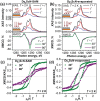Magnetic Hysteresis at 10 K in Single Molecule Magnet Self-Assembled on Gold
- PMID: 33717832
- PMCID: PMC7927621
- DOI: 10.1002/advs.202000777
Magnetic Hysteresis at 10 K in Single Molecule Magnet Self-Assembled on Gold
Abstract
Tremendous progress in the development of single molecule magnets (SMMs) raises the question of their device integration. On this route, understanding the properties of low-dimensional assemblies of SMMs, in particular in contact with electrodes, is a necessary but difficult step. Here, it is shown that fullerene SMM self-assembled on metal substrate from solution retains magnetic hysteresis up to 10 K. Fullerene-SMM DySc2N@C80 and Dy2ScN@C80 are derivatized to introduce a thioacetate group, which is used to graft SMMs on gold. Magnetic properties of grafted SMMs are studied by X-ray magnetic circular dichroism and compared to the films of nonderivatized fullerenes prepared by sublimation. In self-assembled films, the magnetic moments of the Dy ions are preferentially aligned parallel to the surface, which is different from the disordered orientation of endohedral clusters in nonfunctionalized fullerenes. Whereas chemical derivatization reduces the blocking temperature of magnetization and narrows the hysteresis of Dy2ScN@C80, for DySc2N@C80 equally broad hysteresis is observed as in the fullerene multilayer. Magnetic bistability in the DySc2N@C80 grafted on gold is sustained up to 10 K. This study demonstrates that self-assembly of fullerene-SMM derivatives offers a facile solution-based procedure for the preparation of functional magnetic sub-monolayers with excellent SMM performance.
Keywords: XMCD; fullerenes; magnetic hysteresis; self‐assembled monolayers; single‐molecule magnets.
© 2021 The Authors. Advanced Science published by Wiley‐VCH GmbH.
Conflict of interest statement
The authors declare no conflict of interest.
Figures




References
-
- Sessoli R., Gatteschi D., Caneschi A., Novak M. A., Nature 1993, 365, 141.
-
- a) Cervetti C., Heintze E., Bogani L., Dalton Trans. 2014, 43, 4220; - PubMed
- b) Bogani L., Wernesdorfer W., Nat. Mater. 2008, 7, 179. - PubMed
- c) Cucinotta G., Poggini L., Pedrini A., Bertani F., Cristiani N., Torelli M., Graziosi P., Cimatti I., Cortigiani B., Otero E., Ohresser P., Sainctavit P., Dediu A., Dalcanale E., Sessoli R., Mannini M., Adv. Funct. Mater. 2017, 27, 1703600;
- d) Katoh K., Komeda T., Yamashita M., Chem. Rec. 2016, 16, 987; - PubMed
- e) Cornia A., Seneor P., Nat. Mater. 2017, 16, 505; - PubMed
- f) Gaita‐Ariño A., Luis F., Hill S., Coronado E., Nat. Chem. 2019, 11, 301. - PubMed
-
- a) Moreno‐Pineda E., Godfrin C., Balestro F., Wernsdorfer W., Ruben M., Chem. Soc. Rev. 2018, 47, 501; - PubMed
- b) Godfrin C., Ferhat A., Ballou R., Klyatskaya S., Ruben M., Wernsdorfer W., Balestro F., Phys. Rev. Lett. 2017, 119, 187702; - PubMed
- c) Krainov I. V., Klier J., Dmitriev A. P., Klyatskaya S., Ruben M., Wernsdorfer W., Gornyi I. V., ACS Nano 2017, 11, 6868; - PubMed
- d) Urdampilleta M., Klayatskaya S., Ruben M., Wernsdorfer W., ACS Nano 2015, 9, 4458; - PubMed
- e) Ganzhorn M., Klyatskaya S., Ruben M., Wernsdorfer W., Nat. Nanotechnol. 2013, 8, 165; - PubMed
- f) Vincent R., Klyatskaya S., Ruben M., Wernsdorfer W., Balestro F., Nature 2012, 488, 357; - PubMed
- g) Urdampilleta M., Klyatskaya S., Cleuziou J. P., Ruben M., Wernsdorfer W., Nat. Mater. 2011, 10, 502. - PubMed
-
- a) Mannini M., Pineider F., Danieli C., Totti F., Sorace L., Sainctavit P., Arrio M. A., Otero E., Joly L., Cezar J. C., Cornia A., Sessoli R., Nature 2010, 468, 417; - PubMed
- b) Mannini M., Pineider F., Sainctavit P., Danieli C., Otero E., Sciancalepore C., Talarico A. M., Arrio M.‐A., Cornia A., Gatteschi D., Sessoli R., Nat. Mater. 2009, 8, 194. - PubMed
-
- a) Cornia A., Mannini M., Sainctavit P., Sessoli R., Chem. Soc. Rev. 2011, 40, 3076; - PubMed
- b) Domingo N., Bellido E., Ruiz‐Molina D., Chem. Soc. Rev. 2012, 41, 258; - PubMed
- c) Holmberg R. J., Murugesu M., J. Mater. Chem. C 2015, 3, 11986;
- d) Moreno Pineda E., Komeda T., Katoh K., Yamashita M., Ruben M., Dalton Trans. 2016, 45, 18417; - PubMed
- e) Carbone C., Gardonio S., Moras P., Lounis S., Heide M., Bihlmayer G., Atodiresei N., Dederichs P. H., Blügel S., Vlaic S., Lehnert A., Ouazi S., Rusponi S., Brune H., Honolka J., Enders A., Kern K., Stepanow S., Krull C., Balashov T., Mugarza A., Gambardella P., Adv. Funct. Mater. 2011, 21, 1212;
- f) Cornia A., Talham D. R., Affronte M., in Molecular Magnetic Materials (Eds: Sieklucka B., Pinkowicz D.), Wiley‐VCH, New York: 2017, p. 187.
Grants and funding
LinkOut - more resources
Full Text Sources
Other Literature Sources
